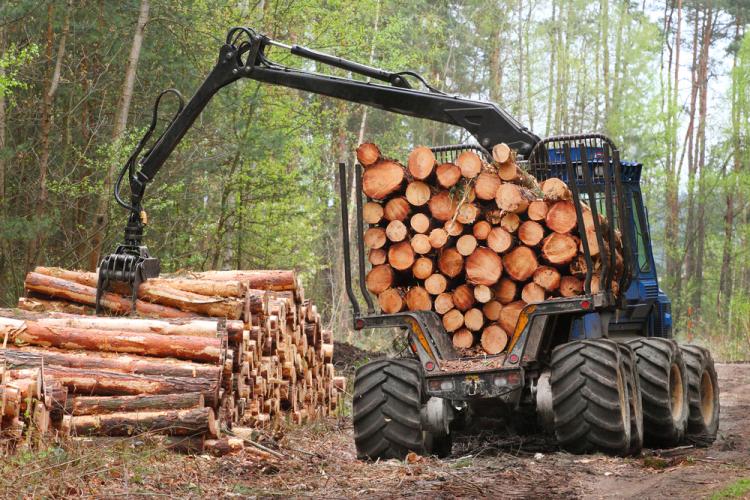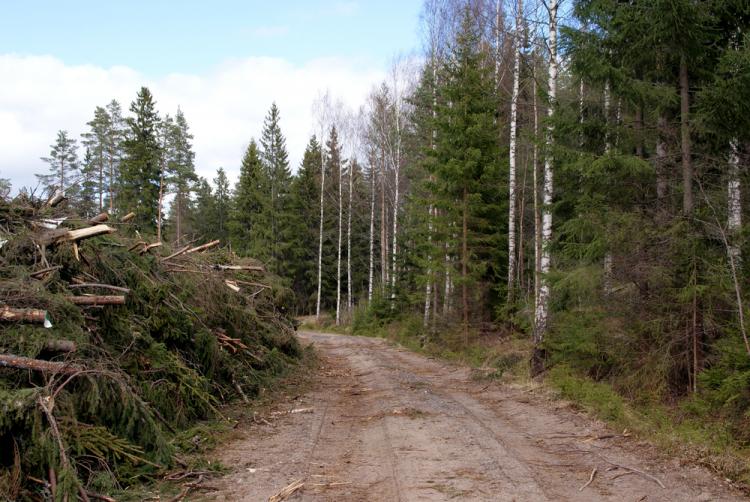Timber Harvesting
The process of cutting trees and transporting them through a forest will disrupt a forest watershed, but you can use Best Management Practices to minimize that disturbance and protect your waterways and wildlife habitat. There are BMPs that can be applied to many phases of timber harvesting including:
- planning
- cutting
- creation of skid trails
- creation of landings
- design and construction of roads.
Pre-harvest Planning
Forethought may be the most important tool you have to avoid problems for your woodland watershed. Without proper planning, your timber harvest may impair the forests’ natural water filtration by compacting soil and altering topography, all of which can cause flooding, diminish water quality, erode topsoil and undermine the life-cycles and survival of wildlife–especially fish and other aquatic species. But by planning your timber harvest carefully you can save time, money and invaluable woodland resources.
A pre-harvest plan may include topographic maps, aerial photographs and soil surveys, as well as an on-the-ground assessment of current conditions. Many resources are available online to assist you in the planning process.
Your pre-harvest plan should consider the location of natural drainage channels, important wildlife habitat, topography and soil type. This will help you make informed decisions about:
- harvest location and boundaries
- location and design of infrastructure like roads and landings
- harvest method
- reforestation strategies.
Pre-harvest planning will help you avoid sensitive sites like wetlands and riparian areas, as well as important wildlife habitats. If these sensitive areas cannot be avoided, the planning process will help you fine-tune your harvest techniques and schedules to minimize disturbance of water resources and wildlife. This may mean harvesting in winter months when the ground is frozen and birds are not nesting; or using specialized machinery and techniques to avoid compaction, rutting and erosion.
A good pre-harvest plan will outline the Best Management Practices that will be followed before, during and after the harvest. These should:
- Identify special areas of protection like wetlands, riparian zones and wildlife habitat.
- Outline the optimal timing of activities, when construction and cutting will cause the least disturbance to soil, water and wildlife.
- Describe special measures for road design and layout.
- Determine harvesting methods.
- Outline a plan for regeneration.
Trees and Harvest Planning
Trees serve an important ecological role and when they are removed from a woodland there are repercussions for the land at large. Everything from forest soil to the success of understory plants to watershed health may suffer their loss. Making management decisions that sustain the ecological work of trees, especially where they are needed most, can save you money and protect the overall health of your land, waters and wildlife.
When planning your harvest consider these tree-related factors:
- The amount of young forest and open land that surrounds your intended harvest area. Too much open pasture or young forest can increase the likelihood of erosion around a timber harvest.
- Plan your harvest so that uncut stands of trees will intercept and absorb runoff from your harvest area.
- Plant and promote tree species that can be harvested by individual or group harvest, rather than large tracts of clear-cut forest.
- Maintain larger, longer-lived trees in riparian zones.
It’s important to keep in mind, Best Management Practices must be flexible and respond to changing conditions. Monitoring the effectiveness of your BMP strategies will help you determine whether they are working and achieving the desired effect of maintaining or improving water quality in your woodland.
Skid Trails
As temporary travel-ways for the transport of logs, skid trails can disrupt your woodland ecology and watershed dynamics.
But if they are thoughtfully designed, you can minimize ill effects and help your woodland recover quickly from any disturbance caused. Here are some BMP guidelines to help you minimize impacts and recover quickly.
- Plan carefully. Minimize the land disturbance from skid trails by constructing them efficiently and thoughtfully.
- Minimize skid trail grades. Trails should not exceed 15 percent grade if at all possible.
- Where steep grades are unavoidable, winch logs uphill rather than constructing a conventional skid trail.
- Employ sediment control measures and drainage structures to prevent erosion.
- Use existing skid trails if they offer the best access and environmental protections. If they do not, consider restoring current skid trails or relocating them to more efficient and environmentally sound locations.
Landings
Landings serve as a place to sort and store logs before they are transported off site. They can be temporary or permanent and can double as meadows for wildlife habitat or parking lots. Because they are subject to very heavy loads, they are prone to compaction and watershed disruption, and are therefore important sites for Best Management Practices. Some important considerations when designing and constructing landings:
- Use existing landings if they are sited for efficient use and environmental protection.
- Close existing landings if they are located in Riparian Management Zones or wetlands, unless construction of new landings would cause even more harm.
- Construct new landings on frozen ground or firm, well-drained soils.
- New landings can have a slight slope to promote efficient drainage.
- Be mindful where you place residue piles. They should not sit in the path of water runoff, which can carry debris into lakes, wetlands or streams.
- Limit the number of landings to the minimum required to meet your harvest objectives.
- Use sediment and drainage control structures where necessary to avoid erosion.
How can I get more tips?
It’s simple! Enter your email below.


